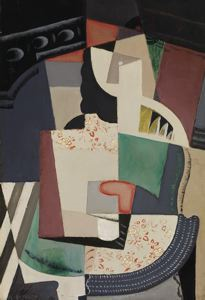
This image is restricted, permission must be requested for reproduction. Downloading for commercial use is prohibited. If you wish to obtain rights to reproduce this image please see our Rights and Reproductions page.
María Blanchard
(Santander, Spain, 1881 - 1932, Paris, France)
Seated Woman (Femme assise)
Femme Assise
c. 1917
Oil on canvas
43 3/4 x 30 1/4 in. (111.1 x 76.8 cm)
Century: 20th Century
Credit Line: Meadows Museum, SMU, Dallas. Museum purchase with funds from The Meadows Foundation, MM.08.02
Accession Number: MM.08.02
More Information
Visual Description
In this painting, approximately 4 feet high and 3 feet wide, Blanchard uses geometric forms in varying hues of cream, rose, green, tan, and gray to portray a seated woman’s head and torso. This pallet of colors, repeated throughout the painting, is a prominent element of the work.The woman’s head is near the top, a little off-center to the viewer’s right. Her cream-colored face and neck are formed by a half-circle and rectangle; her only features are a vertical triangular nose and a horizontal triangular left eye, both in contrasting tan. A tiny cream-colored circle serves as the eye’s pupil. The woman’s hair, seen on the right side of her head, extends to her shoulder in a scalloped charcoal-colored triangle.
The top of her chair, which has a prominent slatted back, extends directly out from her neck and down behind her shoulder, thus combining her head and the chair top into one single abstract form. Her dress, which extends to the edge of the chair seat, is comprised of several modified and overlapping rectangles. These are in varying shades of green, rose, and cream; a collar and part of the cream-colored skirt of her dress are embellished with a soft, intricate floral pattern in rose (that simulates printed fabric). The woman’s dark gray right arm is folded across her body; her hand, a rose-colored mitten shape, holds a small pale gray book.
The bottom of the painting is defined by a charcoal-colored arc representing the edge of the chair seat. It starts in the viewer’s lower right of the painting and continues across the bottom to the center, where it changes into cream-colored shapes and diagonal charcoal and cream stripes. Although the geometric elements of this portrait are flat, they are arranged together to give depth and a three-dimensional effect. The painting surface is smooth; the brush strokes are not a prominent feature of the work.












